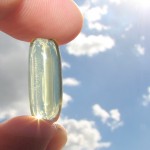
The importance of Vitamin D to health can not be underestimated. It is the only vitamin that our body makes from exposure to sunlight. Learn 10 important things about the “sunshine vitamin” and discover the impact Vitamin D can have on your health.
1. Vitamin D is made from sunlight
 Vitamin D is often referred to as the “sunshine vitamin” because our skin produces vitamin D from the sun’s ultraviolet light (UVB). Our skin can make enough vitamin D in 30 minutes with just our face, hands and feet exposed. Full body exposure for 15 minutes can produce between 10 000 – 20 000IU (international units) of vitamin D3. However, many factors influence our body’s ability to produce vitamin D: complexion, use of sunscreen, cloud cover, smog, time of day, latitude and season.
Vitamin D is often referred to as the “sunshine vitamin” because our skin produces vitamin D from the sun’s ultraviolet light (UVB). Our skin can make enough vitamin D in 30 minutes with just our face, hands and feet exposed. Full body exposure for 15 minutes can produce between 10 000 – 20 000IU (international units) of vitamin D3. However, many factors influence our body’s ability to produce vitamin D: complexion, use of sunscreen, cloud cover, smog, time of day, latitude and season.
Individuals with darker complexions make less vitamin D than fair-skinned people. Studies estimate that half of all women of African descent living in northern latitudes are vitamin D deficient.
Sunscreen use is important for the prevention of skin cancer but it has the unfortunate effect of blocking vitamin D production by blocking UVB rays from reaching our skin.
Cloud cover can reduce UVB energy by 50%, shade reduces it by 60%. UVB rays do not penetrate glass, so exposure to sunshine indoors does not promote vitamin D production.
2. Vitamin D deficiency is a major concern during Canadian autumns and winters
Latitude has a lot to do with vitamin D status. Due to our northern latitude the majority of Canadians have insufficient vitamin D levels during the fall and winter months. One study demonstrated that in Canada from November through February UVB rays aren’t strong enough for our bodies to produce enough vitamin D.
Vitamin D stores in our bodies are quickly depleted during the early autumn months leading to insufficient levels during the late autumn and winter. Vitamin D is stored in the blood for a few weeks and in fat tissue for a few months.
The average vitamin D level in late winter for American and Canadians is approximately 15-18ng/ml – levels below 20ng/ml are considered seriously deficient.
3. Vitamin D can help prevent Influenza and the Common Cold
 Each year more studies are showing a relationship between low vitamin D levels and incidence of colds, influenza and other respiratory tract infections.
Each year more studies are showing a relationship between low vitamin D levels and incidence of colds, influenza and other respiratory tract infections.
People with higher vitamin D levels experience fewer respiratory illnesses and when they do get sick the illness is milder and shorter. The Public Health Agency of Canada is currently investigating the role of vitamin D in the protection against season influenza and the H1N1 (swine flu) strain.
Vitamin D levels in your blood are at their lowest point during flu season. Your body uses vitamin D to make antimicrobial peptides – the body’s natural antibiotics. When vitamin D is deficient you make fewer peptides and are more vulnerable to illness.
Infants and children are a population where respiratory tract infections can have serious health implications. Infants and children with lower levels of vitamin D are more susceptible to viral infections.
Vitamin D supplementation may be used to prevent or treat influenza. To treat influenza larger doses of vitamin D3 may be needed. It is best to consult with a Naturopathic Doctor if you are considering taking high doses of vitamin D as it can be toxic in high doses.
4. Vitamin D may prevent Cancer
You might not know it, but the connection between vitamin D status and cancer is well established in the scientific community. Adequate levels of vitamin D have been shown to decrease the risk of developing over 16 different types of cancer including breast, ovarian, prostate, pancreatic, colon, non-Hodgkins lymphoma and lung cancer. It is also an important part of integrative cancer treatment protocols.
A study by Dr. W. Grant, vitamin D expert, found that about 30 percent of all cancer deaths (2 million worldwide) could be prevented each year with higher levels of vitamin D.
Vitamin D can protect against cancer in several ways, including:
- Increased self-destruction (apoptosis) of mutated cells
- Reduced spread (metastasis) and reproduction (proliferation) of cancer cells
- Increased differentiation of cells (cancer cells often lack differentiation)
- Reduced growth of new blood vessels from pre-existing ones, which is a step in the transition of dormant tumors turning cancerous
Other studies have estimated that you can decrease your risk of developing cancer by more than half by optimizing vitamin D levels.
5. Vitamin D is essential for bone health
 Vitamin D deficiency results in childhood rickets and in osteomalacia (under-mineralized bone) in adults. Without sufficient vitamin D bones become thin, brittle or misshapen.
Vitamin D deficiency results in childhood rickets and in osteomalacia (under-mineralized bone) in adults. Without sufficient vitamin D bones become thin, brittle or misshapen.
Osteoporosis is a very common disease in North America. It is characterized by fragile bones that significantly increase the risk of fracture. Long term vitamin D insufficiency is associated with the development of osteoporosis. Supplementing calcium and vitamin D can help protect adults from developing osteoporosis. Vitamin D is necessary to allow the body to absorb calcium, either from dietary or supplemental sources. Vitamin D also lowers the risk of fractures in people with osteoporosis.
6. Vitamin D can decrease the risk of Auto-Immune diseases
Vitamin D is one hard working vitamin! Not only can it decrease the risk of cancer, common cold, influenza and osteoporosis, but it can also decrease the risk of developing several auto-immune diseases. Conditions such as autism, type I diabetes mellitus, schizophrenia and rheumatoid arthritis all have been correlated with low levels of vitamin D.
One auto-immune condition has been studied extensively with relation to vitamin D status. Multiple sclerosis (MS) is a chronic auto-immune disease that occurs almost exclusively in extreme latitudes and rarely near the equator. In MS the immune system attacks the body’s own cells as “foreign”, causes vision changes and muscle weakness. Adequate vitamin D levels may decrease the incidence of MS. It is also an important integrative treatment for people with MS.
7. Vitamin D is essential for children and breastfed infants
 Levels of vitamin D in breast milk have been found to be lower than needed for proper growth and development in infants (breast milk contains about 25IU/litre). Because of this finding breastfed infants are recommended to be supplemented with 400IU of vitamin D daily (formula is also supplemented with vitamin D). Supplementing at this young age could have life-long benefits.
Levels of vitamin D in breast milk have been found to be lower than needed for proper growth and development in infants (breast milk contains about 25IU/litre). Because of this finding breastfed infants are recommended to be supplemented with 400IU of vitamin D daily (formula is also supplemented with vitamin D). Supplementing at this young age could have life-long benefits.
Older children and adolescents also benefit from vitamin D supplements. The American Academy of Pediatrics suggests supplementing all children to ensure adequate vitamin D levels.
8. Vitamin D can help prevent Type I and Type II Diabetes
More obese adults are deficient in vitamin D than same-age adults with normal weights. A large percentage of adults with type II diabetes are also obese. 60% of people with type II diabetes have inadequate levels of vitamin D in their blood. If you are obese, supplementing with vitamin D may help decrease your risk of developing type II diabetes. If you already have type II diabetes supplementing with vitamin D can help improve insulin sensitivity.
Scientific studies have also established a link between type I diabetes and vitamin D levels. Deficient levels of vitamin D are frequently found in patients diagnosed with type I diabetes and some research supports supplementation of vitamin D to decrease the risk of type I diabetes. Children supplemented with vitamin D were also found to be less likely to develop type I diabetes.
9. Vitamin D levels can be tested – and should be!
The only way to determine the correct dose of vitamin D for you to take is to get your blood levels tested. There are currently 2 different vitamin D tests available. The best one is 25-hydroxyvitamin D. This is a better marker of overall vitamin D status than 1,25-hydroxyvitamin D.
Vitamin D levels should be tested for three reasons.
- Vitamin D requirements are different for everyone. Depending on your age, colour of your skin, weight, and latitude of the town you live in, you could need anywhere from 400IU to over 10 000IU per day!
- Vitamin D can be toxic in excessive doses. Vitamin D accumulates in fat tissues where it is stored for a few months. Vitamin D overdose causes hypercalcemia (too much calcium in the blood), dehydration and tissue calcification. Blood tests showing levels of greater than 200nmol/L of vitamin D are toxic. It is very difficult to reach this level through sunlight exposure or nutritional sources of vitamin D. Toxicity has been seen with long term supplementation of excessive levels of vitamin D. Having your blood levels tested will ensure you are not taking excessive dosages of vitamin D.
- Vitamin D insufficiency is often asymptomatic. It is possible to have low levels of vitamin D in your body and not be aware of it. The only way to know you have optimal levels of vitamin D is to test for it.
Vitamin D Levels (25-hydroxyvitamin D)
| Deficient | Insufficient | Optimal | Cancer therapy | Excess |
| <25ng/ml | <35ng/ml | 50-65ng/ml | 65-90ng/ml | >100ng/ml |
| <20nmol/L | <40-80nmol/L | 80-120nmol/L | 120-160nmol/L | >200nmol/L |
10. Not all Vitamin D supplements are created equal
 There are two types of vitamin D available; Vitamin D2 (ergocalciferol) and Vitamin D3 (cholecalciferol). Only Vitamin D3 should be used for supplementation. Vitamin D2 is a synthetic form of Vitamin D and does not impact vitamin D stores in our bodies in the way Vitamin D3 does. Vitamin D3 is the natural form, the same form our bodies create from sun exposure.
There are two types of vitamin D available; Vitamin D2 (ergocalciferol) and Vitamin D3 (cholecalciferol). Only Vitamin D3 should be used for supplementation. Vitamin D2 is a synthetic form of Vitamin D and does not impact vitamin D stores in our bodies in the way Vitamin D3 does. Vitamin D3 is the natural form, the same form our bodies create from sun exposure.
Vitamin D3 is better absorbed in a liquid form. Several companies make liquid Vitamin D3.
Food sources of Vitamin D3 (fortified milk, fish, cod liver oil, egg yolk, mushrooms) are often insufficient to maintain optimal levels of Vitamin D3. Especially during the winter months in Canada, supplementation is necessary.
As of 2012, the conventional RDAs (recommended daily allowances) in Canada are only:
- 400 IU for infants and children
- 600 IU for adolescents and adults aged 9-70
- 800 IU for adults over 70
- 600 IU for pregnant and breastfeeding women
These levels are completely inadequate for maintaining optimal health, especially in the autumn and winter months in Canada. The only way to determine an adequate (and safe) dosage of Vitamin D is with a blood test. However, general guidelines from the scientific literature suggest a dosage of:
Vitamin D3 Dosage Guidelines
|
35IUs of Vitamin D3 per pound of body weight |
For a child weighing 40 pounds, a dosage of approximately 1400 IU would be reasonable and for a 160 pound adult the dose would be approximately 5600 IU’s. This dosage is for a fair skinned healthy young adult. It is a guideline only and does not suggest that all adults and children should be taking these doses.
Conclusion
Achieving adequate levels of vitamin D is important! Reduce your risk of cancer, influenza, respiratory tract infections, diabetes, auto-immune diseases and improve your bone health and overall health with just one vitamin supplement daily.
Photo courtesy of Jamie Amodeo. www.flickr.com/jamieamodeo
Photo Credit: ellesmere FNC via Compfight cc
Resources:
Aloia JF, Ni-Ng M. Re: epidemic influenza and vitamin D. Epidemiol Infect. 2007 Oct;135(7):1095-6; author reply 1097-8.
Aloia JF, Patel M, Dimaano R, Li-Ng M, et al. Vitamin D intake to attain a desired serum 25-hydroxyvitamin D concentration. Am J Clin Nutr. 2008 Jun;87(6): 1952-8.
Autier P, Gandini S. Vitamin D Supplementation and Total Mortality: A Meta-analysis of Randomized Controlled Trials. Arch Intern Med. 2007 Sep 10;167(16):1730-7.
Cannell JJ, Vieth R, Umhau JC, et al. Epidemic influenza and vitamin D. Epidemiol Infect. 2006 Dec;134(6):1129-40.
Cannell JJ, Zasloff M, Garland CF, Scragg R, Giovannucci E. On the epidemiology of influenza. Virol J. 2008 Feb 25;5:29.
Ginde AA, et al. Association between serum 25-hydroxyvitamin D level and upper respiratory tract infection in the Third National Health and Nutrition Examination Survey. Arch Intern Med. 2009 Feb 23;169(4):384-90.
Grant WB. An estimate of premature cancer mortality in the United States due to inadequate doses of solar ultraviolet-B radiation, Cancer, 2002b;94:1867-75
Grant WB. Geographic variation of prostate cancer mortality rates in the USA; implications for prostate cancer risk related to vitamin D; Int. J. Cancer, 2004 Sep 1;111(3):470-1
Grant WB. Lower vitamin-D production from solar ultraviolet-B irradiance may explain some differences in cancer survival rates. J Natl Med Assoc. 2006 Mar;98(3):357-64.
Gordon CM, Feldman HA, Sinclair L, et al. Prevalence of Vitamin D Deficiency Among Healthy Infants and Toddlers. Arch Pediatr Adolesc Med. 2008;162[6]:505-512.
Health Canada, Vitamin D and Calcium: Updated Dietary Reference Intakes: http://www.hc-sc.gc.ca/fn-an/nutrition/vitamin/vita-d-eng.php
Holick MF. Calcium and Vitamin D. Diagnostics and Therapeutics. Clin Lab Med. 2000 Sep;20(3):569-90
Holick MF. High prevalence of vitamin D inadequacy and implications for health. Mayo Clin Proc. 2006
Mar;81(3):353-73
Hypponen E, Laara E, Reunana A, Jarvelin MR, Virtanen SM. Intake of vitamin D and risk of type 1 diabetes: a birth-cohort study. Lancet. 2001;358:1500-3.
Ingraham BA, Bragdon B, Nohe A. Molecular basis of the potential of vitamin D to prevent cancer. Curr Med Res Opin. 2008;24:139-49.
Laaksi I, et al. An association of serum vitamin D concentrations <40nmol/L with acute respiratory tract infection in young Finnish men. Am J Clin. Nutr. 2007 Sep;86(3):714-7.
Mayo Clinic Information Sheets: www.mayoclinic.com/health/vitamin-d/NS_patient-vitamind”>vitaminD
Dr. Mercola website: http://articles.mercola.com/sites/articles/archive/2004/03/31/cancer-sunlight.aspx
Merlino LA, Curtis J, Mikuls TR, et al. Vitamin D intake is inversely associated with rheumatoid arthritis: results from the Iowa Women’s Health Study. Arthritis Rheum. 2004;50:72-7.
Munger KL, Levin Ll, Hollis BW, Howard NS, Ascherio A. Serum 25-hydroxyvitamin D levels and risk of multiple sclerosis. JAMA. 2006 Dec 20;296(23):2832-8.
Robsahm TE, Tretli S, Dahlback A, Moan J. Vitamin D(3) from sunlight may improve the prognosis of breast-, colon- and prostate cancer (Norway). Cancer Causes Control. 2004;15:149-58.
Wagner CL, Greer FR: American Academy of Pediatrics Section on Breastfeeding: American Academy of Pediatrics Committee on Nutrition. Prevention of rickets and vitamin D deficiency in infants, children, and adolescents. Pediatrics 2008;122:1142-52.
Webb AR, Kline L, Holick MF. Influence of season and latitude on the cutaneous synthesis of vitamin D3: exposure to winter sunlight in Boston and Edmonton will not promote vitamin D3 synthesis in human skin. J Clin Endocrinol Metabl. 1988;67:373-8.
Zella JB, DeLuca HF. Vitamin D and autoimmune diabetes. J Cell Biochem. 2003;88:216-22

















As mentioned in the article, new studies on Vitamin D are being published almost every day! This morning I found this new study on Vitamin D and asthma:
“Vitamin D Levels, Lung Function and Steroid Response in Adult Asthma,” Sutherland ER, Goleva E, et al, Am J Respir Crit Care Med, 2010 Jan 14; [Epub ahead of print].
The study looked at 54 non-smoking adults with asthma and found that low vitamin D levels were associated with decreased lung function and decreased response to glucocorticoid mediations. Lower vitamin D levels were also associated with increased airway hyper-responsiveness. The study results suggest that “supplementation of vitamin D levels in patients with asthma may improve multiple parameters of asthma severity and treatment response.”
A second study recently released:
“Benefit-risk assessment of vitamin D supplementation,” Bischoff-Ferrari HA, Shao A, et al, Osteoporos Int, 2009 Dec 3; [Epub ahead of print].
This study looked at the risk of taking vitamin D in relation to the potential health benefits and concluded that “vitamin D levels of 75 to 110 nmol/l provide optimal benefits for all investigated endpoints without increasing health risks. These levels can be best obtained with oral doses in the range of 1,800 to 4,000 IU vitamin D per day”.
These dosage recommendations are in line with those mentioned in the article – 35IU per pound of body weight.
It’s exciting to see research support for Naturopathic treatments. Traditional wisdom, modern research and healthy lifestyle. That’s what Naturopathic Medicine is all about.
Keep posting stuff like this i really like it
[…] are a number of natural treatments for influenza. Bed rest, warming socks, vitamin D, vitamin C, zinc, Echinacea, Ginseng, Andrographis, Astragalus, Goldenseal, Larch arabinogalactans, […]
[…] enough vitamin D. That means 20 minutes of direct sunlight every day from May-October and a daily vitamin D supplement during Canadian winters (November to April). Inadequate stomach acid also reduces calcium […]
[…] vitamin D. That means 20 minutes of direct sunlight every day from May-October and a daily vitamin D supplement during Canadian winters (November to April). Inadequate stomach acid also reduces calcium […]
for more click here…
[…]we like to honor other sites on the web, even if they aren’t related to us, by linking to them. Below are some sites worth checking out[…]…
read more…
[…]just below, are some totally unrelated sites to ours, however, they are definitely worth checking out[…]…
[…] your daily vitamin D. Vitamin D is used by your body to make antimicrobial peptides – the body’s natural […]
[…] you live in Canada you need to take a vitamin D supplement through the fall and winter. All of us – mothers, fathers, grandparents and kids all […]
[…] skin or live in colder climates (like Canada) you may have a vitamin D deficiency. Low levels of vitamin D can contribute to the development of fibroids and can lead to inflammation and altered insulin […]
[…] Vitamin D, an incredibly important nutrient for Canadians, has profound impacts on endometriosis. Vitamin D regulates cell growth and differentiation in endometriosis, enhances macrophage action and decreases inflammation. Vitamin D supplementation has been found in studies to reduce the weight of endometriosis lesions as well. […]
[…] http://www.realfarmacy.com/johns-hopkins-scientist-reveals-shocking-report-flu-vaccines/ [7]https://www.drlisawatson.com/10-things-you-need-to-know-about-vitamin-d#sthash.v6BNaYzZ.dpuf [8]http://www.kenneallyacupuncture.com/newsletter-othermenu-40.html […]